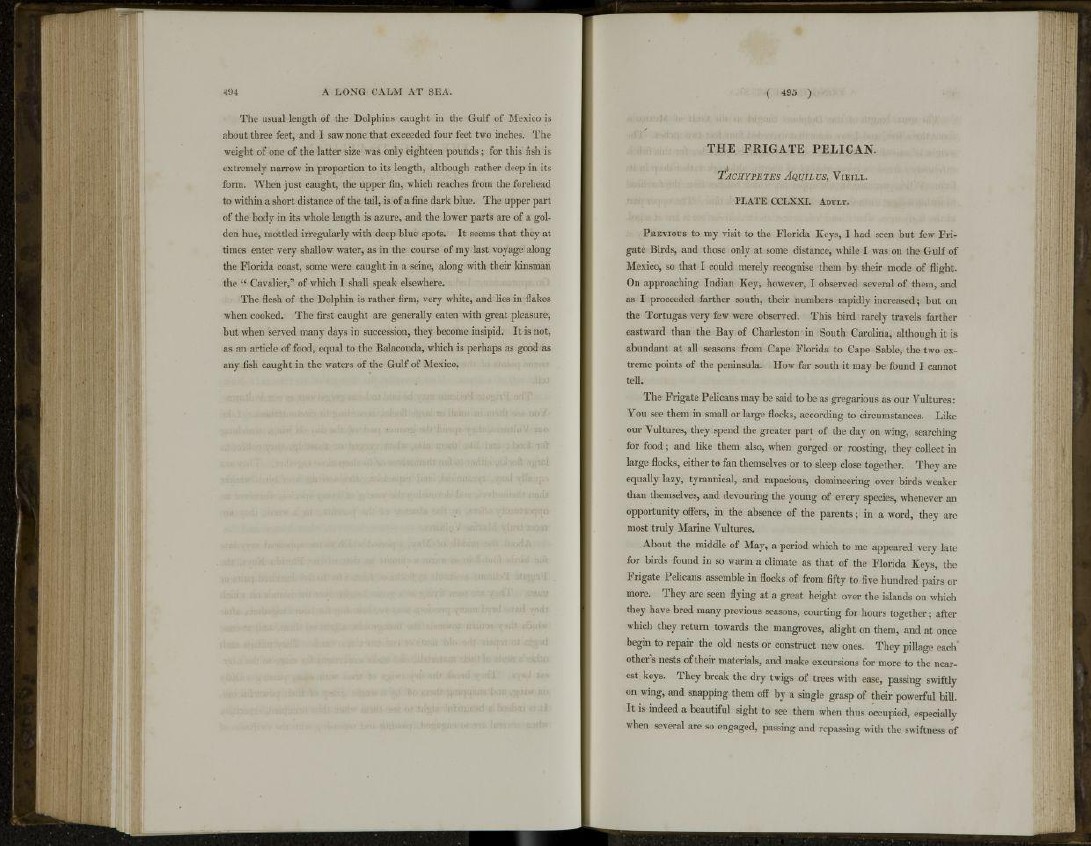
494 A LONG CALM AT SEA.
The usual length of the Dolphins caught in the Gulf of Mexico is
about three feet, and I saw none that exceeded four feet two inches. The
weight of one of the latter size was only eighteen pounds; for this fish is
extremely narrow in proportion to its length, although rather deep in its
form. When just caught, the upper fin, which reaches from the forehead
to within a short distance of the tail, is of a fine dark blue. The upper part
of the body in its whole length is azure, and the lower parts are of a golden
hue, mottled irregularly with deep blue spots. It seems that they at
times enter very shallow water, as in the course of my last voyage along
the Florida coast, some were caught in a seine, along with their kinsman
the " Cavalier," of which I shall speak elsewhere.
The flesh of the Dolphin is rather firm, very white, and lies in flakes
when cooked. The first caught are generally eaten with great pleasure,
but when served many days in succession, they become insipid. It is not,
as an article of food, equal to the Balacouda, which is perhaps as good as
any fish caught in the waters of the Gulf of Mexico.
( 495 )
THE FRIGATE PELICAN.
TACHYPETES AQUILUS, VIE ILL.
PLATE CCLXXI. ADULT.
PREVIOUS to my visit to the Florida Keys, I had seen but few Frigate
Birds, and those only at some distance, while I was on the Gulf of
Mexico, so that I could merely recognise them by their mode of flight.
On approaching Indian Key, however, I observed several of them, and
as I proceeded farther south, their numbers rapidly increased; but on
the Tortugas very few were observed. This bird rarely travels farther
eastward than the Bay of Charleston in South Carolina, although it is
abundant at all seasons from Cape Florida to Cape Sable, the two extreme
points of the peninsula. How far south it may be found I cannot
tell.
The Frigate Pelicans may be said to be as gregarious as our Vultures:
You see them in small or large flocks, according to circumstances. Like
our Vultures, they spend the greater part of the day on wing, searching
for food; and like them also, when gorged or roosting, they collect in
large flocks, either to fan themselves or to sleep close together. They are
equally lazy, tyrannical, and rapacious, domineering over birds weaker
than themselves, and devouring the young of every species, whenever an
opportunity offers, in the absence of the parents; in a word, they are
most truly Marine Vultures.
About the middle of May, a period which to me appeared very late
for birds found in so warm a climate as that of the Florida Keys, the
Frigate Pelicans assemble in flocks of from fifty to five hundred pairs or
more. They are seen flying at a great height over the islands on which
they have bred many previous seasons, courting for hours together; after
which they return towards the mangroves, alight on them, and at once
begin to repair the old nests or construct new ones. They pillage each
other's nests of their materials, and make excursions for more to the nearest
keys. They break the dry twigs of trees with ease, passing swiftly
on wing, and snapping them off by a single grasp of their powerful bill.
It is indeed a beautiful sight to see them when thus occupied, especially
when several are so engaged, passing and repassing with the swiftness of